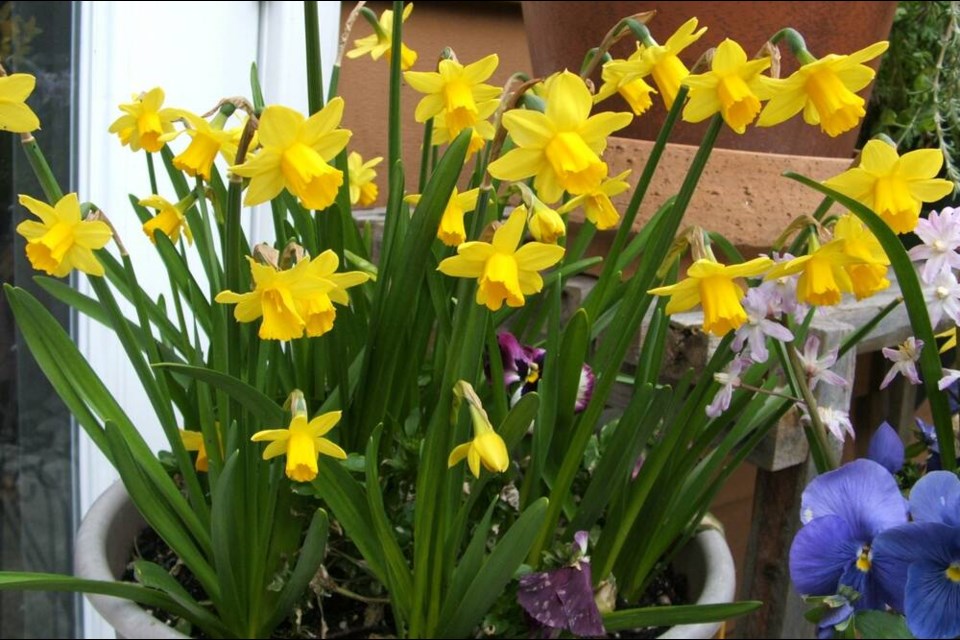Dear Helen: A few years ago, planting bulbs in “layers” in containers was very popular. I no longer hear about it much. Is this method of planting still recommended? I have purchased an assortment of spring-flowering bulbs, and I have two matching patio tubs, each 35 cm wide and 25 cm deep. I’d appreciate some tips on the planting process.
L.B.
Planting bulbs in tiers is actually a useful method, in containers and in the open garden, for growing as many flowering plants as possible into small spaces. It is especially helpful for people who have only containers or very small spaces for gardening.
You can plant spring-flowering bulbs in two or three layers. First, place a drainage layer in each container. I use bagged wood shavings, the kind used to line small animal cages. They are light-weight, and they save on the amount of potting mix needed to fill the container.
Add planting mix over the drainage layer, and nestle the bottom layer of bulbs into it — close together, but not touching. What bulbs are planted in the bottom layer will depend on whether you will need the container for planting with summer flowers in April or early May. If it will be needed, avoid planting late flowering bulbs and stick to early tulips (Single Early, Double Early, Fosteriana), daffodils and hyacinths.
If you won’t need the container until late spring or early summer, the bottom layer could be a later-flowering tulip. Mid-season Triumph tulips are excellent for pots, or you could choose a late flowering tulip from among the Single Late, Double Late (Peony), Fringed, Parrot, Lily-Flowered and Viridiflora (Green) tulip classes. Bulb packaging indicates the bloom period.
Almost all the small flower bulbs are also early to bloom and are used as the upper planting layer. Commonly used here are crocus, dwarf iris, glory of the snow (Chionodoxa), early dwarf daffodils, and Anemone blanda.
A typical three-tiered bulb planting has small bulbs over daffodils over tulips. Hyacinths are also suitable in the middle layer.
For a two-tiered container that will bloom early, simply use small bulbs over daffodils, alone or with hyacinths.
For a full and compact, space-saving display of spring flower bulbs in the open garden, plant in similar tiers. Excavate the space to around 23 cm. Loosen the soil at the bottom and enrich it with fertilizer and compost before starting to plant.
The potting mix in the planted containers needs to be kept just modestly moist. Place the containers in a location protected from fall and winter rains (May they begin before too much longer). Against a house wall, under broad eaves, usually works well. Water through the fall and winter only enough to keep the planting mix from drying out.
Bring the containers into a display area in late winter or early spring, as soon as the first top growth appears.
Dear Helen: I’m not sure when to harvest my winter squash and pumpkins. Some of the vines have almost completely died down while the leaves on others are still in decent shape.
S.N.
When a squash or pumpkin has matured and is ready for harvesting, the stem attached to the fruit will have turned woody. In most cases, it will also have turned brown. And the skin should have hardened. Leave five to eight cm of stem.
To further harden the skins and “cure” harvested squash and pumpkins prior to storing them, first make sure they are clean. Then place them in a warm location for a week. I usually set them by the wood stove, which I’ve not yet used because of the warm weather. Instead, I have placed my harvested winter squash and pumpkins on trays at a sunny window. After the curing period, they will store best a cool site, ideally between 7 and 10 C.
GARDEN EVENTS
Nanaimo meeting. The Nanaimo Horticultural Society will meet this evening (Wednesday, Oct. 12) at 7 p.m. in First Unitarian Fellowship Hall, 595 Townsite Rd. in Nanaimo. Gordon Cowan will speak about keeping bonsai.
Floral art. The Mid Island Floral Art Club will meet on Thursday at 2 p.m. in St. Stephen’s Church hall, 150 Village Way in Qualicum Beach. The meeting will feature members’ demonstration. Guest fee $6. New members are welcome. Information at 250-757-8969.



